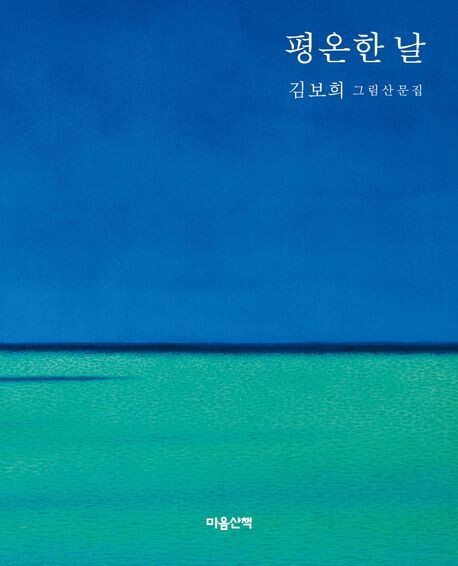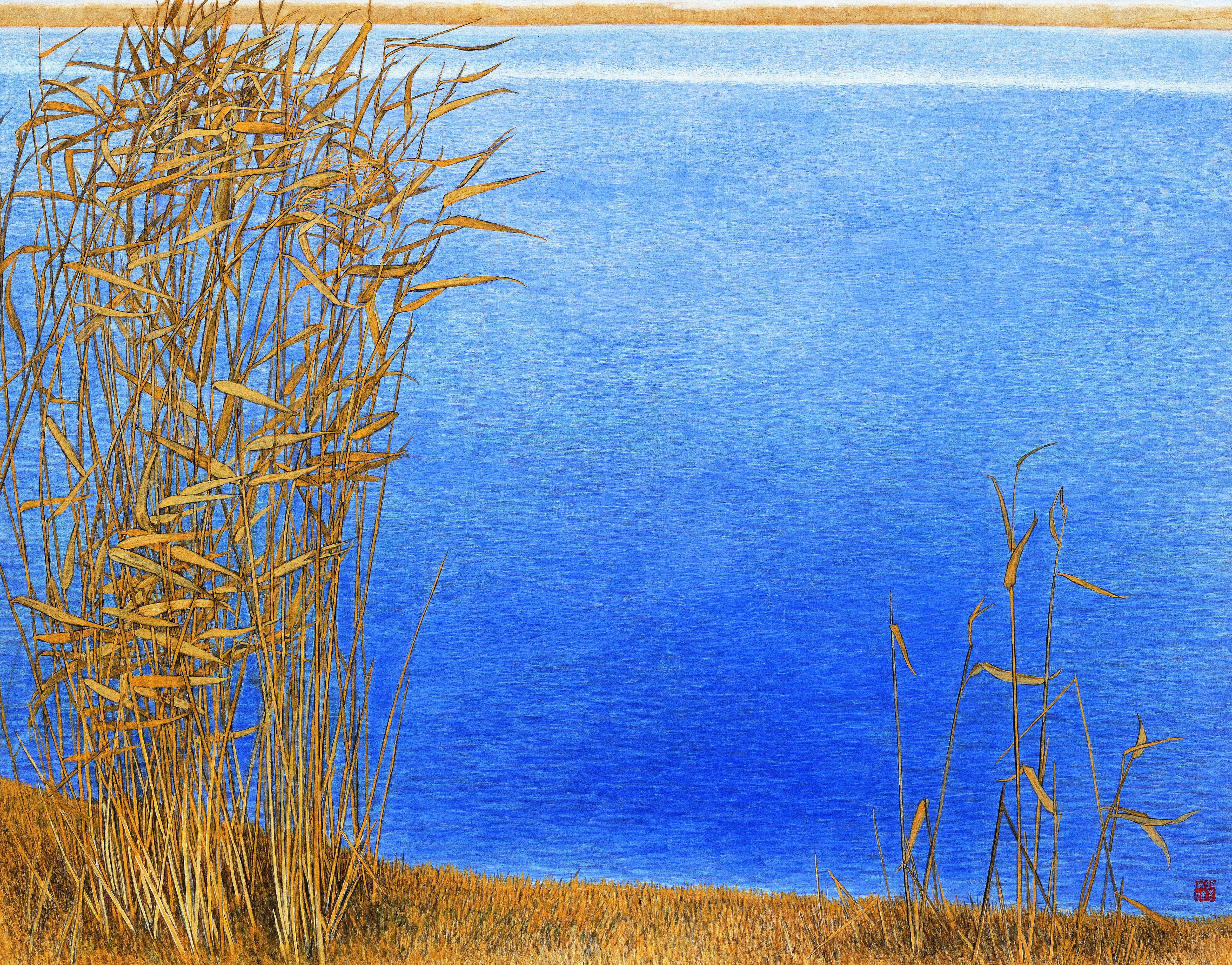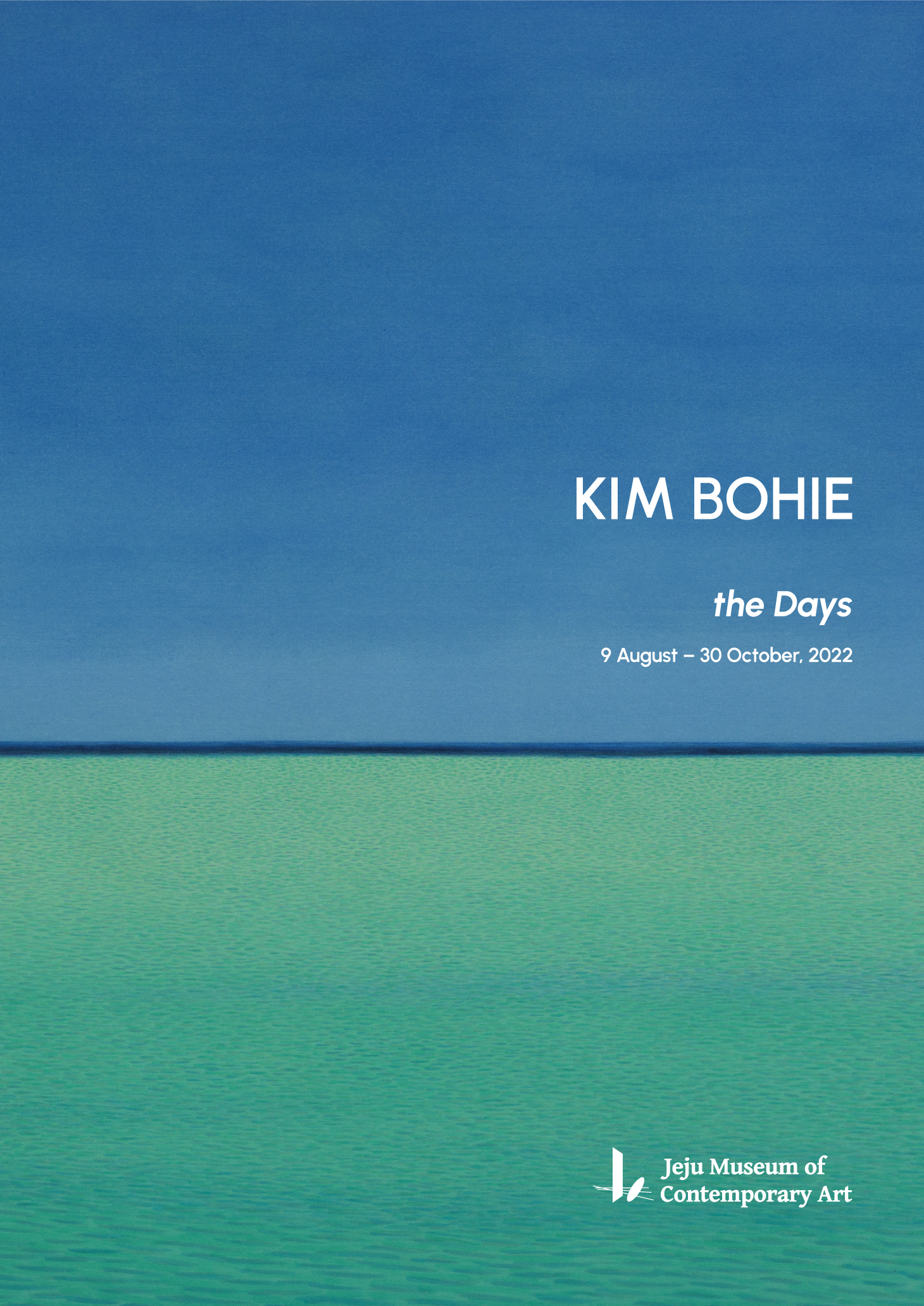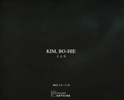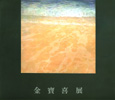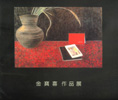1995.10.26 ~ 11.01 월전미술관 윤난지 <자연을 바라보는 나지막한 시선: 김보희의 근작>
자연을 바라보는 나지막한 시선: 김보희의 근작
글. 윤난지
의미 있는 미술이라는 것이 미술가가 대면한 현실-그것은 정신적 실체일수도, 시각적 대상일수도, 사회적 사실일수도, 예술내적 문제일수도 있다-에 대한 진실한 접근을 전제로 한다고 할 때, 현대를 사는 미술가들이 진정 우리 시대에 속한 미술을 이루려는 의지를 보이는 것은 당연한 일일 것이다. 그러나 한편으로는 미술도 다른 영역과 마찬가지로 역사 속에서 축적된 문화의 산물인 점 또한 부정할 수 없으므로 전통의 전수와 동시대성의 성취라는 문제는 미술가들에게 있어 항상 풀어야 할 주요 과제가 되어왔다. 특히 동양화 재료를 사용하는 전통적인 미술의 수련을 통하여 화가수업을 시작한 소위 ‘동양화가' 또는 ‘한국화가'로 불리운 미술가들에게 있어서는 이러한 문제가 더욱 심각한 갈등으로 던져지는 경우가 많았던 점은 쉽게 짐작할 수 있다.
김보희도 수업기에 동양화 재료와 기법, 그리고 그 정신을 전수받는 한편 자신이 속한 시대의 예술의식에도 민감하게 반응하지 않을 수 없었던 작가들 중 하나이다. 그는 전통과 동시대성, 또는 정체성과 보편성의 문제를 갈등의 관계로 접근하지 않고 오히려 이에 초연한 태도에서 출발하는 방향에서 해결의 실마리를 찾은 듯 하다. 자신의 그림이 채색화가 아니라 그저 색채가 있는 풍경화라고 밝히는 그의 입장에서 알 수 있듯이 그는 두 문화의 공통의 지평에서 출발함으로써 나름대로의 방법에 도달하였다. 그의 그림은 복합적인 문제들을 의식적으로 종합한 결과라기 보다 작가의 고유의 심성에서 출발하여 개성적인 양식을 이룸으로써 문제들이 무리 없이 해결된 결과인 것이다.
인물이나 정물, 풍경 등을 막론하고 김보희가 그려온 소재들은 공통적으로 익명의 대상들이다. 우리가 무심결에 마주치게 되는 평범한 인물들과 일상의 사물들, 그리고 친근한 자연의 모습들이다. 근작에서는 자연의 풍경이 주요 소재로 그려지고 있는데, 제주도나 서울 근교의 실제 경관을 그린 풍경화가 주류를 이루고 있다. 파도가 밀려오는 바닷가 모래밭, 들풀들로 무성한 벌판, 잡목 사이로 난 작은 길 등 이 그림들에 그려진 자연은 빼어난 절경이라기보다 인적이 드문 곳에서 우연히 마주치게 되는 정경들이다. 우리가 그의 작품에 편안하게 다가가게 되는 것도 이러한 소재상의 특성과 무관하지 않은 것으로 보인다.
이러한 점에서 김보희의 그림은 동양화에서 말하는 실경산수 또는 서구의 사실주의 풍경화 전통에 속한다고 할 수 있는데, 이 작가의 독특한 측면은 소재를 단지 과장 없이 충실하게 재현하는데 그치지 않고 그것을 마음에 비추어진 모습으로 그려내는 점에 있다. 그것은 하잘 것 없는 일상적인 정경에서도 잔잔한 시정을 찾아내는 이 작가의 따뜻한 심성에서 기인하는 것이다. 대상에 대한 그 특유의 태도는 그림에서 구체적으로 구도와 색채, 기법 등을 통하여 우리에게 전달된다. 그의 화면이 우리에게 설득력 있게 다가오는 것은 이러한 형식적 요소들이 의식적으로 탐구된 것이라기 보다 대상에 대한 작가의 태도에서 자연스럽게 발현된 것이기 때문이다.
김보희의 전 작품을 통해서 우리가 시종 감지하게 되는 것은 작가의 자연을 바라보는 나지막한 시선이다. 대부분의 그림에서 지평선이나 수평선을 높이 올려 그리고 있는 점은 이러한 그의 시선을 매우 시사적으로 드러내고 있다. 높은 수평선은 풍경을 낮은 위치에서 뿐 아니라 매우 가까이에서 보고 있는 작가의 존재를 알려준다. 자연을 높은 위치에서 내려다보는 화가들의 시점이 자신과 일정한 거리를 두고 자연을 대면하거나 그것을 제압하려는 태도를 드러낸다면 낮은 시점은 겸허한 태도로 자연에 조응하고자 하는 태도를 대변한다는 것이 결코 무리한 해석은 아닐 것이다. 낮은 시점에서 올려다 본 자연의 모습 앞에서는 보는 이 또한 풍경에 더욱 바짝 다가가게 되어 풍경을 바라본다기 보다 그 속에 자신이 담겨 있다는 느낌을 갖게 된다.
그에게 있어 자연을 가까이에서 본다는 것은 그것의 세부를 시각적으로 접근한다는 것이 아니라 심리적으로 그것에 가깝게 다가간다는 것을 의미하며, 따라서 오히려 그것을 전체로서 감지하게 된다는 것을 의미한다. 그의 그림이 다양한 모양의 섬세한 필치들로 이루어졌음에도 불구하고 그 속에서 매우 절제된 간소한 구성을 포착하게 되는 것은 이와 같은 태도에서 기인하는 것이다. 그의 화면은 우리의 눈을 화면 깊숙이 이끌고 가기보다 수직의 표면을 평면적으로 이동하게 함으로써 우리로 하여금 눈 앞에 펼쳐진 자연의 모습을 하나의 색면구성으로써 경험하게 한다. 자연을 심상의 반영으로 보는 그의 태도로 인하여 대상을 충실히 재현하고 있는 화면에도 이와 같은 추상성이 부여되고 있는 것이다.
자연의 이치를 거스르지 않으려는 그의 태도는 화면 전체에 흐르는 정적인 분위기를 통해서도 드러나고 있다. 특히 수평선 위주의 구성으로 인하여 화면의 적막감은 더욱 강조되고 있다. 이들 풍경화는 몇몇 예외를 제외하고는 수평의 면과 선이 주를 이루고 있으며 수직의 요소들은 화면에 활력을 주는 요소로서 하나 둘 첨가될 뿐이다. 수직선은 동적이고 남성적이며 수평선은 정적이며 여성적이라는 몬드리안의 글을 떠올리지 않더라도, 그의 그림 앞에 선 관람자는 경탄과 흥분보다는 침묵과 평정의 상태를 경험하게 되는 것이다.
이와 같은 효과는 화면을 이루는 가라앉은 중간 색조에서도 유래한다. 그는 다양한 톤의 청회색과 황갈색을 주로 사용하고 있으며, 청록색이나 연두색 같은 다소 화려한 색채도 전체적인 톤을 방해하지 않는 범위에서 조심스럽게 쓰고 있다. 바위나 돌담을 이루는 검은색도 상대적으로 밝은 색채들과 균형을 이루면서 지나치지 않은 범위에서 화면에 강세를 부여하고 있다. 이와 같이 결코 과장된 색채를 사용하지 않는 그의 방법에서도 눈 앞의 자연을 왜곡하거나 변형하지 않으려는 그의 겸손한 자세를 읽을 수 이다.
달콤한 파스텔 조의 그림의 경우 밝고 따뜻한 느낌을 주면서도 경박한 느낌을 주지 않는 것은 그것들이 중간색조의 색면에 의해 제어되고 있기 때문이기도 하지만 세필의 중첩으로 나타나는 은근한 깊이감 때문이기도 하다. 그는 우선 먹의 필치로 바탕을 개략적으로 구성한 다음 그 위에 다양한 색채의 필치로 계속 덧칠해 가면서 화면을 만들어 나간다. 이때 동양화 물감 특유의 속성으로 인하여 밑칠 한 색채들이 은근히 배어 나오면서 투명한 물감의 층을 이루게 된다. 우리는 색채들의 중첩으로 이루어진 이와 같은 공간에서 청량한 대기 속에 녹아 드는 관선과 같은 비물질적인 실체를 감지하게 된다.
이와 같은 기법은 인상주의자들의 그것과 매우 흡사하다. 그러나 인상주의자들이 전 화면을 균질적인 필치로 그리는 것에 비해 그는 대상에 따라 다양한 필치를 선택적으로 적용한다. 그리하여 가늘고 긴 선, 짧고 단속적인 점, 두껍고 큰 붓 자국, 넓은 색면 등 갖가지의 채색 기법이 화면 위에서 결합되고 있다. 이것은 대상을 물리적인 광선의 반사체로 보기 보다 각기 독특한 심리적 반응을 일으키는 개별적 존재들로 접근하는 이 작가 특유의 자세를 말해주며, 이러한 측면에서 서구의 인상주의자들과는 다른 면모를 발견하게 된다.
이름없는 풍경을 간소한 색채와 구성에 담아내고 있는 김보희의 화면은 그 자신의 소박하고 맑은 심성을 반영하는 거울과 같은 것이다. 그의 작품이 다소 단조로운 느낌을 줄지는 몰라도 과장된 표현이 난무하는 시가환경 속에서 사는 현대인에게는 잠시나마 시끄러운 일상을 떠나 자연의 정적 속에 묻히게 하는 그런 그림이 더욱 필요한 것인지도 모른다. 대상의 충실한 묘사와 구성 상의 조화를 동시에 성취하면서 시적인 감수성 까지를 담아내고 있는 그의 작품은 동양화와 서양화라는 진부한 구분을 벗어나 개성적인 풍경화의 영역을 이루고 있다. 그의 그림은 진정한 동시대성이란 자신의 소리에 진실하게 귀 기울임으로써 성취된다는 것을 보여 주는 하나의 예이다. 온갖 잡다한 실험들이 폭주하는 이 시대에 자연이라는 영원한 주제를 자신만의 방법으로 성실하게 탐구하고 있는 김보희와 같은 화가야말로 우리시대를 사는 바람직한 예술가의 모습 중의 하나일 것이다.
Looking at Nature with a Humble Attitude: Recent works of Bo Hie Kim_Nan Ji Yun(Art Critic)
If meaningful art is based on the confrontation between artist and reality- whether depiction mental entity, visual subject, social reality, or inner artistic problems- it is natural for the artists living in the modern world to show the will to achieve art that truly encapsules our period of time. Meanwhile, however, as it is the case in other areas, we also cannot deny the fact that art is a product of accumulated culture throughout history. Thus it has always been a major task for the artists to transmit tradition and to attain the contemporaneity. The artists who were classified under as so called “Eastern Painters” or “Korean Painters” began their practice through traditional training methods using ingredients from Eastern painting. We can easily assume that for these artists, such problems were dealt as a serious conflict in many cases.
Bo Hie Kim inherited materials, methods and spirits of Eastern painting. She is one of the many artists who had to response sensitively to the artistic consciousness of the time period where she herself was included as well. Instead of approaching the relationships of the conflict between tradition and contemporaneity or originality and universality, Kim appears to search for a solution of the problem by departing from a detached attitude.
She seems to inform us that her painting is not a ‘che sek hwa'(Oriental color painting) but a mere landscape with the application of colors. She starts from a same horizon of two cultures and reaches a method of her own.
Where it is a portrait, a still-life or a landscape, the subject matters which Kim renders are all anonymous. They are ordinary people, everyday objects, and familiar images of nature that we pass by without ever realizing them. In her recent works, landscapes of nature have been treated as her main subject. The majority of them consists actual existing sceneries such as Cheju Island and suburban areas of Seoul. Sandy seaside with rippling waves, vast field with thickly covered wild grass, small path formed by bushes…nature depicted in these paintings is not a spectacular view, but a scene we encounter accidentally in a place where very little traces of man is noticeable. The viewers can thus approach her work with comfort due to the distinctive characteristics of the subject matter.
It can be said that such aspect of Kim's works shows the traditions of “Shil Kyung San Su”(an actual existing landscape)from Eastern painting and realist landscape painting of the west. The unique quality of the artist, however, is that Kim does not stop by faithful recreation of the subject, but executes it by reflection her feelings. From insignificant and ordinary setting, she finds serene and poetic sentiment. A specific attitude toward the subject is delivered to the perceivers by the means of composition, color, and technique. Kim's images come to us with persuasiveness because such formal elements are not studied intentionally but manifested from the artist's personal view on the subject.
We often sense the artist's humble attitude towards nature in all her works. We sense it in the horizontal line drawn high above that is shown in most of her pictures. It suggests the existence of the artist herself who is not only looking at the scenery from below but also who is looking at it very nearby. If the artists who look down at nature from a higher point reveal confrontation of nature with distance or a controlling attitude, we can carefully interpret that the artist looking from below shows her modest position in correspondence with nature. The latter signifies more that just immediate proximity. We come to find ourselves inside the landscape as well.
For Kim, looking at nature closeby does not mean visually approaching its details. She approaches psychologically and thus senses it as a whole. For example, despite the fact that her paintings are created by various shapes of refined brushstrokes, we are able to capture a very restrained and simple composition. Instead of guiding our eyes deep inside the picture plane, Kim's pictures enable us to move around two dimensionally on the surface of the picture. As a result, we experience the representation of nature as one of the color compositions. From her view seeing nature as a projection of the ordinary, and even in the process of faithful rendition, such abstractness is endowed.
Instead of resisting against the laws of nature but approaching them quietly, Kim's subtle attitude is visible in the silent mood that overlies through the entire canvas. The horizontal composition heightens the desolate quality. Except for a few, majority of her landscapes consist horizontal zone and line. Vertical elements are added now and then to give energy to the picture. Even if we do not recall Mondrian's words that vertical line is dynamic and masculine and horizontal line is static and feminine, the viewer experiences silence and tranquility rather than wonder and excitement.
Such effect comes from subdued middle toned colors composing the picture. Kim uses variety of bluish gray and yellowish brown. She also uses somewhat bright colors with caution such as bluish green and light green to an extent of not disturbing the overall tone. Black applied to render rocks and stoned walls create a sense of balance with relatively bright colors. Thus it accentuates the pictorial atmosphere in a subtle manner. As Kim's technique shows her abandonment of bombastic colors that avoids any kind of distortion or change, we can detect her modest view on nature.
Sweet and soft pastel toned pictures provide a sense of brightness and warmth but they do not reveal any sense of lightness because they are restrained by the middle toned hues. It is also due to subtle depth formed by the accumulation of the brushstrokes. Kim first roughly composes the background by black ink brushstrokes and then creates the picture by overlapping with various colors. By the property of Oriental paint, the paint on the bottom smudges upward and forms a layer of transparent paint. In a space produced by the piling of colors, we can sense a nonmaterial substance like the melting rays of sunshine in a cool and crisp atmosphere.
Such technique is very similar to that of the Impressionists. However, where they created a picture with homogeneous touches, Kim applies various touches selectively depending on the subject. Therefore, various color schemes such as thin and long lines, short and controlled dots, big and thick brush marks, and widely colored areas are all integrated in a single picture plane. Instead of seeing the object as a reflection of light but as an individual existence that provokes unique psychological reaction, it shows the distinct perspective of the artist. In this aspect, we find features that are quite different from the western impressionists.
The landscape produced by Kim that contains nameless scenery and simple color composition is a mirror reflecting simple and pure nature of the artist herself. Her work may be perceived as a bit monotonous at first. But for moderns living in a visual environment exposed to bombastic expressions, Kim's picture is what they need where one can escape from the hustle and bustle of everyday life and absorb oneself in the silence of nature. Achieving both faithful rendition and composition of the subject at the same time, and possessing the poetic sensitivity as well, Kim's work frees itself from the old-fashioned classification of Eastern and Western paintings. It forms a unique domain of landscape painting. It serves as an example showing that true contemporaneity is accomplished by listening seriously to the artist's own voice. Where our period is congested with miscellaneous experiments, Kim continues to work diligently using the eternal subject nature and her unique methods. Kim can be regarded as one of the most desirable artists living today.
